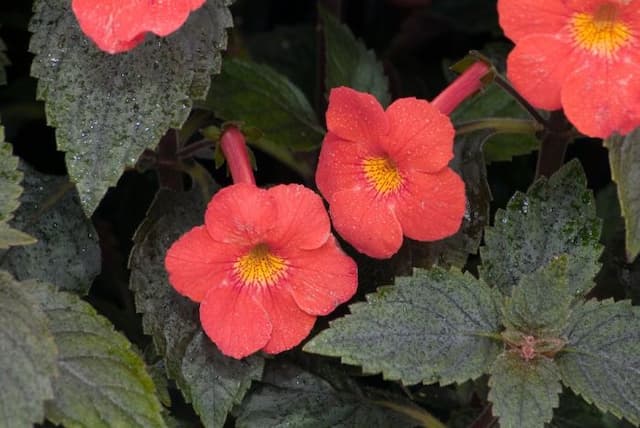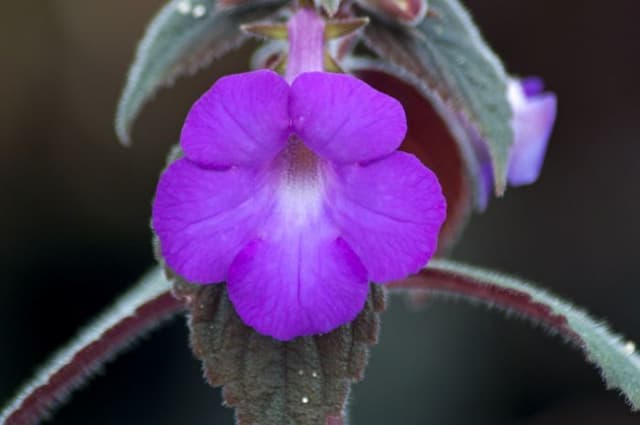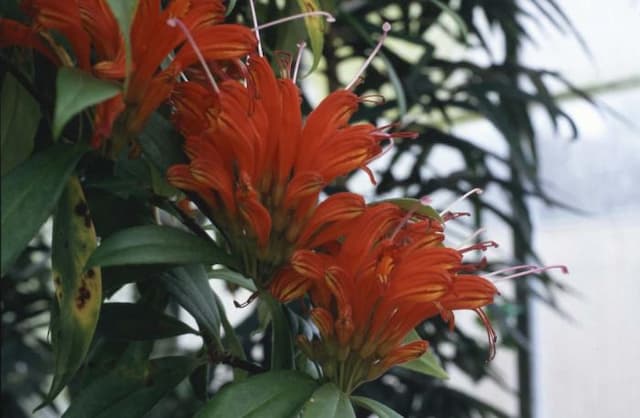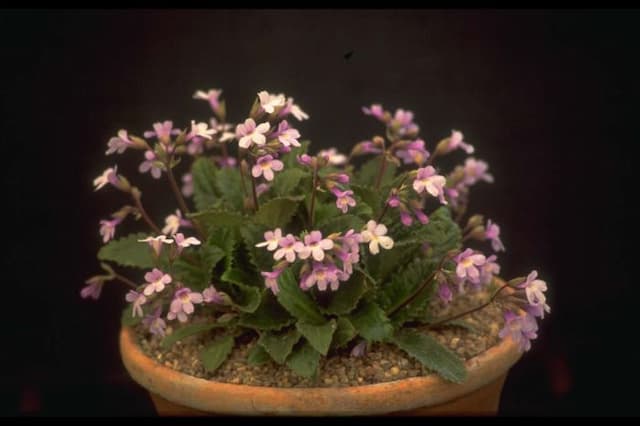Dryas Primrose Primulina dryas

ABOUT
Primulina dryas, commonly known as neither of the terms provided, so I'll proceed with using the botanical name, is best known for its striking appearance which is characterized by rosettes of lush, velvety leaves. Each leaf flaunts a deep green color with a distinctive, paler veining pattern that adds to its ornamental charm. The foliage often emerges in a symmetrical arrangement, creating a visually appealing structure. In contrast to the luxurious leaves, the plant bears delicate flowers that sprout on slender stems. The blossoms are shaped like little funnels or bells and exhibit a range of colors, often in pastel hues such as soft pinks, purples, or whites. These flowers are generally grouped together at the ends of the stems, forming clusters that rise above the leafy base of the plant. Overall, the aesthetic appeal of Primulina dryas lies in its combination of plush foliage and dainty floral arrangements, making it a desirable species for enthusiasts of ornamental plants.
About this plant
 Names
NamesFamily
Gesneriaceae
Synonyms
Dryas Primulina
Common names
Chirita dryas.
 Toxicity
ToxicityTo humans
Information specifically regarding the toxicity of Primulina dryas to humans is not readily available. Therefore, extreme caution should be exercised, and it should be assumed that consuming any part of this plant may be harmful until proven otherwise. If a plant is poisonous, symptoms of poisoning can range from mild (such as nausea, vomiting, or diarrhea) to severe (such as organ failure or neurological damage), depending on the plant and amount ingested. Without specific toxicity data on Primulina dryas, it is not possible to describe exact symptoms of poisoning in humans.
To pets
As with toxicity to humans, specific information on the toxicity of Primulina dryas to pets is not well documented. Pet owners should consider this plant potentially harmful until more information becomes available. If a plant is poisonous to pets, common symptoms of poisoning often include vomiting, diarrhea, drooling, lethargy, or loss of appetite. Severe cases could lead to more serious health issues. Exercise caution and prevent pets from ingesting any part of this plant.
 Characteristics
CharacteristicsLife cycle
Perennials
Foliage type
Evergreen
Color of leaves
Green
Flower color
Blue
Height
0.5 feet (15 cm)
Spread
0.5 feet (15 cm)
Plant type
Herb
Hardiness zones
10
Native area
China
Benefits
 General Benefits
General Benefits- Ornamental Value: Primulina dryas, commonly known as Fairy Primrose, adds aesthetic appeal to gardens and indoor spaces with its attractive foliage and flowers.
- Low Maintenance: It is relatively easy to care for, requiring minimal pruning and care once established.
- Shade Tolerant: This plant can thrive in shady areas where other plants might struggle, making it a good choice for less sunny spots.
- Humidity Tolerance: Fairy Primroses can tolerate humid environments, which is beneficial for maintaining the plant in bathrooms and kitchens.
- Long Blooming: The Fairy Primrose often enjoys a long flowering period, providing color and interest in the garden for an extended time.
- Compact Size: Its small size makes it suitable for container gardening, terrariums, or small garden spaces.
 Medical Properties
Medical PropertiesThis plant is not used for medical purposes.
 Air-purifying Qualities
Air-purifying QualitiesThis plant is not specifically known for air purifying qualities.
 Other Uses
Other Uses- Ornamental Display: Primulina dryas is often grown for its attractive foliage and striking flowers, which add beauty when displayed in homes and gardens.
- Terrarium Plant: Due to its small size and humidity preferences, it can be an ideal addition to terrariums and fairy gardens.
- Botanical Illustration: Artists and botanists may use Primulina dryas as a subject for botanical illustration, capturing the plant's detailed structure.
- Photography Subject: The unique appearance of its flowers makes it a compelling subject for photographers, especially those specializing in macro photography.
- Educational Tool: Used in schools or educational workshops to teach about plant biology, specifically gesneriad family characteristics.
- Cultural Symbol: In some cultures, the plant may be used symbolically in festivals or artistic representations due to its unique appearance.
- Collector’s Item: Hobbyists may seek out different varieties of Primulina dryas, as its various hybrids offer a range of colors and forms.
- Gift Plant: Its low maintenance and attractive blooms make it a popular choice as a gift for plant enthusiasts.
- Floral Arrangements: Sometimes leaves or flowers are used in live or dried floral arrangements for their unique aesthetic.
- Garden Design: Used to create texture and interest in shade gardens or rockeries, complementing other foliage and flowering plants.
Interesting Facts
 Feng Shui
Feng ShuiThe Primulina is not used in Feng Shui practice.
 Zodiac Sign Compitability
Zodiac Sign CompitabilityThe Primulina is not used in astrology practice.
 Plant Symbolism
Plant Symbolism- Endurance: Primulina dryas is known for its ability to thrive in rocky and challenging environments, symbolizing the capacity to endure and persevere through tough conditions.
- Rarity: As a less common plant, Primulina dryas often represents uniqueness and the value of rare beauty in the world.
- Adaptability: The plant's adaptability to different habitats can symbolize the ability to adjust and be flexible in varied life situations.
 Water
WaterThe primulina, commonly known as the Chinese Violet, should be watered regularly to maintain slightly moist soil, particularly during its active growth period in spring and summer. Watering should be done with approximately 8-16 ounces of water every week, depending on the size of the pot and the humidity level of the environment. The plant should not sit in water, so ensure proper drainage is available and avoid letting the pot's tray fill up with excess water. During the fall and winter months, reduce watering to every other week, allowing the top inch of soil to dry out between waterings.
 Light
LightThe Chinese Violet prefers bright, indirect light, making it suitable for placement near an east or north-facing window where it can enjoy plenty of light without the harshness of direct afternoon sun. Avoid direct sunlight which can scorch the leaves, and provide some light shade if grown in a south-facing window. Inadequate light can cause the plant to become leggy and affect blooming.
 Temperature
TemperatureChinese Violets thrive in temperatures between 65 and 75 degrees Fahrenheit, making them well-suited for typical indoor environments. It is important to keep the plant away from drafts and sudden temperature changes, as it can be sensitive to cold. It should not be exposed to temperatures below 50 degrees Fahrenheit, as this can cause damage to the plant.
 Pruning
PruningPrune Chinese Violets to remove any dead or yellowing leaves and maintain a pleasing shape. This promotes healthy growth and encourages more blooms. The best time to prune is in the spring, just before the new growth begins. Pruning can be done occasionally throughout the year to remove spent flowers and any leggy growth, which keeps the plant looking tidy and well-managed.
 Cleaning
CleaningAs needed
 Soil
SoilThe optimal soil mix for the plant commonly known as Fairy Primrose should be light and well-draining, consisting of a blend of 50% peat or coco coir, 30% perlite, and 20% vermiculite or coarse sand to provide aeration. The ideal soil pH for Fairy Primrose should be slightly acidic to neutral, ranging from 6.1 to 7.5.
 Repotting
RepottingFairy Primrose should be repotted once every year or two as they outgrow their current container, ideally during spring or early summer. Use a slightly larger pot each time to allow for growth and refresh the soil mix to provide nutrients.
 Humidity & Misting
Humidity & MistingFairy Primrose thrives in moderate to high humidity levels, around 50-70%. To maintain high humidity, use a humidifier or place the pot on a tray filled with pebbles and water.
 Suitable locations
Suitable locationsIndoor
Grow Fairy Primrose in bright, indirect light indoors and water when dry.
Outdoor
Place Fairy Primrose in partial shade outdoors and protect from strong winds.
Hardiness zone
Fairy Primrose is suitable for 10-11 USDA.
 Life cycle
Life cyclePrimulina dryas, also known as Dryas Monkey Flower, begins its life cycle as a seed that, upon germination in a moist and warm environment, develops into a small seedling with few leaves. The seedling then grows into a vegetative plant with characteristic fuzzy leaves and may form a small rosette as it matures. When environmental conditions are favorable, typically in spring to summer, it produces flowering stalks with clusters of attractive, tubular flowers that can be pollinated by insects. After pollination, the flowers develop into capsules containing numerous tiny seeds. The plant may enter a period of dormancy, particularly if it experiences cooler or drier conditions. With the onset of the next favorable growing season, Primulina dryas can continue to grow vegetatively and flower annually, completing its life cycle over several years.
 Propogation
PropogationPropogation time
Spring to Summer
Propogation: Primulina dryas, commonly known as a type of Primrose, can be propagated most effectively in the spring or early summer when the plant's growth is most active. The most popular method of propagation for Primulina is leaf cuttings. A healthy leaf with a petiole is carefully cut from the plant and inserted into a moist, well-draining soil mixture. It should be placed in indirect light and high humidity to encourage root development, which usually takes a few weeks. Once roots form, the new plant can be gradually acclimatized to less humid conditions and eventually repotted as an independent plant. This method is favored for its simplicity and the relatively high success rate among hobby and professional gardeners alike.









